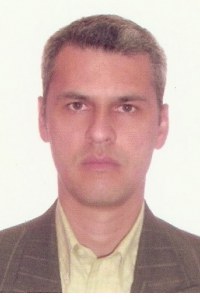

Lamosa Quinteiro, Santiago
Department of Crop Production / University of Santiago de Compostela/ Escuela Politécnica Superior, Campus Universitario de Lugo / 27002 Lugo, Spain
+34 982 28 59 00 ext. 23111 / slamosa@lugo.usc.es
Martínez Caamaño, María DoloresDepartment of Crop Production / University of Santiago de Compostela/ Escuela Politécnica Superior Campus Universitario de Lugo / 27002 Lugo, Spain+34 982 28 59 00 ext. 23111 / mariadolor.martinez2@rai.usc.esRegueira Gay, Rubén JoséDepartment of Agroforestry Engineering / University of Santiago de Compostela / Escuela Politécnica Superior, Campus Universitario de Lugo / 27002 Lugo, Spain+34 982 2859 00 ext. 23263 / regueira@lugo.usc.esBarrasa Rioja, MartínDepartment of Agroforestry Engineering / Universidad de Santiago de Compostela / Escuela Politécnica Superior, Campus Universitario de Lugo / 27002 Lugo, Spain+34 982 2859 00 ext. 23263 / mbarrasa@lugo.usc.es
ABSTRACT
ABSTRACT
The reduction of work-related accidents is one of the greatest challenges that any professional activity has to tackle. One sector historically omitted from the Health and Working Conditions Survey in Spain (EWCS), including the last one published in 2007, has been the agricultural sector and with it, the landscaping and grounds maintenance subsectors that boomed in the last few years.
Given this situation we have implemented a methodology that allows us tobecome familiar with the working conditions in the landscaping and grounds maintenance sector of the Autonomous Region of Galicia in Spain. In this article we explain our results and conclusions.
Keywords
Keywords
Landscaping, grounds maintenance, work-related health and safety, Health and Working Conditions Survey (EWCS)
INTRODUCTION
INTRODUCTION
A growing interest in the environment together with the economic growth of the last few years in Spain have brought about the appearance of numerous public and private green areas as well as the creation of a new business activity: companies devoted to landscaping and grounds maintenance. In fact, landscaping is considered by the European Union and by Spain as a new source of job creation and at the same time as an activity with great growth prospect.
In Spain in 2001 public bids for gardens projects exceeded 1.500 million euros, while the Autonomous Region of Galicia invested 105 million euros.
It is estimated that in Spain in 1998 the average of green areas in provincialcapitals was about 16 m2 per resident [1]. As for Galicia, the surface area of green zones in some cities rose to [2]:• 1.500.000 m2 in A Coruña 6 m2 per resident
• 1.300.000 m2 in Santiago de Compostela with 14 m2 per resident
• 790.000 m2 in Ourense with 7 m2 per resident
• 700.521 m2 in Lugo which represents 8 m2 per resident
On the other hand, the European Union recommends a ratio along the lines of 10 m2 per resident, which gives us an idea of the importance of the landscaping sector in Galicia and the anticipated growth as a result of adapting to the European recommendations.
In Galicia in 2002 there were more than 110 businesses dedicated to the landscaping and environmental sectors with great diversity with respect to the number of employees, billing, legal status, and activities performed [2], of which more than 50 belonged to the Galician Association of Landscaping Businesses (AGAEXAR), with more than 500 employees [3].
At present, the reduction of work-related accidents is one of the biggest challenges that any professional activity has to tackle. Work safety is an issue that has to involve the business owners as well as the business executives and the staff, who have to take into account prevention of occupational hazards, health monitoring, training, involvement of the staff, safety regulation, emergency plans, liquid storage, and personal protection equipment.
By using a small sample of employees in a selected area, Working Conditions Surveys (EWCS) are one of the fastest and most economical procedures that allow us to become familiar with occupational hazards and work-related health problems that affect employees of a given area.
The European Union carried out its first EWCS in 1990, and has repeated these surveys every five years since. They are coordinated by the European foundation for the improvement of Living and Working Conditions (EUROFOUND), located in Dublin and covering the 25 Member States.
In Spain the National Institute for Occupational Safety and Health (NIOSH) is responsible for this survey and it has carried out six up to this moment: 1987, 1993, 1997, 1999, 2003 y 2007 [4]. Aside from that, during the last several years, several autonomous regions have carried out their EWCS, for example, Navarre (1997 and 2005) [5], Valencia (2003) [6], Catalonia (2006) [7] and Castile-Leon (2006) [8], among others. Nationally, the agricultural sector had been excluded from the EWCS up until the last one in which 686 surveys were conducted at the national level and 52 were conducted at the regional level in Galicia.
The absence of a specific survey for Galicia and the characteristics of the national surveys that deal with the study of work conditions, classifying the active work population in large groups of workers, do not permit us to diagnose the state of the galician agricultural sector with precision. This sector, which has its own identity, merits a different treatment.
This work presents the first of a series of surveys that will allow us to penetrate the galician agricultural sector in a specific way, and we hope it will contribute to the application of effective measures that make it possible to improve labor conditions.
OBJECTIVES
The objective of this work is to study the health and working conditions of the landscaping sector of Galicia. This objective is broken down into three more specific goals:
• Identify the frequency of exposure to various occupational hazards and characterize the most frequent work-related exposures• Understand internal work factors that influence workers' health• Evaluate the preventative measures that companies have implemented
METHODOLOGY
As a starting point for creating the questionaire we used the Sixth National Survey of Working Conditions [9] that consists of 76 questions organized into 15 blocks. Maintaining the same organized structure with the ultimate purpose of adapting the questionnaire to the predetermined objectives, we have added a series of specific questions at the end of each block, which adds up to a total of 50 of our own questions that were added to the 76 original questions.
This survey was divided into two clearly different parts: the first survey, directed to the person in charge of the business, consisted of 21 questions and asked for information about the characteristics of the business. The second one, directed at the workers, focuses on the individual aspects of their job. The most relevant results of some of the blocks that were analyzed are presented in these findings.
The study sample was composed of workers employed in the landscaping sector in the four Galician provinces. The number of workers surveyed was 31 working in 17 different businesses.
The field work was completed from December 2007 to January 2008. The surveys were conducted through personal interviews in the workplace and all of them were performed by the same interviewer.
RESULTS
The results are organized into nine chapters: 1. Sample Description, 2. Prevention Organization and Preventative Activities, 3. Safety Conditions, 4. Environmental Conditions, 5. Job Position Design, 6. Physical Burdens of the Job, 7. Mental Burdens of the Job, 8. Psychosocial Factors, 9. Health Status of the Working Population.
In this article we have focused on four concrete chapters: 1. Sample Description, 2. Prevention Organization and preventative activities, 3. Psychosocial Factors, 4. Health Status of the Working Population. The following are the most relevant results.
Sample Description
The total number of workers surveyed has been about 31, of which 89.7% were men and 10.3% women. Figure 1 demonstrates the distribution of workers by the size of the companies’ staff.
45
 |
|
4540 |
35
 |
|
30 24251720 14151050 |
1-9 10-49 50-249 > 500
SIZE OF COMPANY'S WORKFORCE
Fig. 1. DISTRIBUTION OF WORKERS BY THE SIZE OF THE COMPANY’S WORKFORCE
The distribution of workers by age group is shown in figure 2. 82.8% are found in the range of ages between 25 and 44 years old.
345-55

41
 |
|
35-44 |
4125-34
1416-24
0 10 20 30 40 50
% OF WORKERS
Fig. 2. DISTRIBUTION OF WORKERS BY AGE
The percentage of the workers surveyed that were Spanish was 86.2%, compared to 13.8% that were foreign. Within the group that made up the workers with nationalities other than Spanish, in relation to the total sample, those originating from Bolivia (6.9%) predominated, followed by Argentina (3.4%) and Portugal (3.4%).
As far as the training of the surveyed workers is concerned, it is important to point out that at the moment they were hired, the great majority, 75%, had not done any specific studies for the job that they were going to provide, and that 25% received training courses after they were hired.
Prevention Organization and Preventative Activities
In this chapter we analyze: the knowledge that the worker possesses aboutthe occupational hazard prevention organization that their company has adopted, the methods adopted by the companies, risk studies performed, as well as medical exams, etc.
It's notable that a high percentage of workers do not know the safety and hazard prevention department of the company, and its preventative activities: 41.4% of the employees did not know what managing authority responsible for occupational safety and hazard prevention was available in the company, 31% do not know if there is a prevention delegate at their job and 31.3% do not know of the existence of the occupational safety and health committee (Fig 3).
60 55
 |
|
50 |
38
 |
|
4031 31 31 |
30
20 14
delegate committee
|
100yes no don't know |
RESPONSE
Fig. 3. EXISTENCE OF THE PREVENTION DELEGATE AND/OR THE HEALTH AND SAFETY COMMITEE
94.1% of the companies use an outside prevention service and 5.9% have their own prevention service.
37.9% of the companies did some risk study for the safety and health of their workers. In every case they analyzed noise, followed by the handling of noxious or toxic substances or products (80%), machine, equipment, and material safety (80%), vibrations analysis (60%) and work postures (60%) (Fig. 4).
ORGANIZATION 0

0
POSITION DESIGN30
SAFETY FAC ILITIES
MAC HINE SAFETY ERGONOMIC S30
BIOLOGIC AL AGENTS
TOXIC SUBSTANC ES20
RADIATION
VIBRATIONS10
AIR TEMPERATURE
80
60
80
60
100
NOISE
0 20 40 60 80 100
% OF COMPANIES
Fig. 4. FACTORS ANALYZED IN THE OCCUPATIONAL HAZARD STUDIES
After the aforementioned studies, 40% of the companies implemented some type of change, 80% modified or supplied personal protection equipment and trained and informed the workers about occupational hazards, and 60% modified or created facilities, machinery, equipment or materials and collective protection resources.
Psychosocial Factors
This section describes the data obtained related to aspects such as social support, professional development and job satisfaction, autonomy, job stability, etc.
93.1% of those surveyed could obtain help from their co-workers if they ask for it, and 86.2% could get help from their supervisor, which demonstrates the great amount of social support perceived by the workers and the trust in their supervisors.
90.6% of those surveyed stated that they feel that they do the best that they know how to do. 86.2% consider their work to be well done, and 100% have the impression that they perform useful work. These values highlight the worker's high level of personal skill development and their elevated level of self-fulfilment.
89.7% of those surveyed claimed to have freedom to choose vacation and off days. 86.2% can put their own ideas in practice at work. 79.3% change the order of tasks and 82.7% can divide up their work breaks, which reflects the workers high level of autonomy (Fig. 5).

Fig. 5. PERCEPTIONS OF VARIOUS PSYCHOSOCIAL FACTORS
As for job stability, 89.6% of those surveyed think that they are not going to lose their job in the next six months.
The average amount of hours worked is around 40 hours per week, distributed between a typical Spanish workday with a long midday break, 82.8% of those surveyed, and a continuous workday with a short break and earlier quitting time, 17.2%.
24.1% of the workers occasionally go on trips of over 200 km, and they do itin company vehicles designated for transporting work crews and work tools. In 37.5% of the cases the time spent in transit was added to the workday. Moreover, a member of the work crew always drives, and in 75% of the cases, the same person does it during the entire trip even if it is a long distance. That becomes important, if we take into account 25% go back home everyday.
Health Status Of The Worker Population20.7% of the workers surveyed have had an accident on the job in the last two years. Strained postures or overstraining were the causes of 33.3% of these accidents, aspects related to traffic produced another 33.3%, and the last 33.3% was the result of other causes.3.4% of the workers were or are in the process of being examined for job-related illness. 100% of those cases deal with illnesses of the bones, muscles, or joints.
It's notable that 27.6% of the population surveyed thinks that their jobaffects their health. 75% of these agree that work caused them back pain, 50% that it caused pain in their upper limbs and 37.5% hearing loss (Fig. 6)

Fig. 6. AFFECT OF THE JOB ON THE WORKER’S HEALTH
82.8 % of those surveyed were given medical examinations in the company and 66.7% think that they have performed all the tests necessary to determine if they have a work-related illness.
CONCLUSIONS
• In Galicia the landscaping sector is characterized by a high number of microenterprises and small companies. It employs mainly men (more than 89%), making up the age range from 25 to 44 years old (more than 82%). Foreign workers make up 14% which are predominantly Latin American and Portuguese.
• A great majority of workers don't know the occupational safety and hazard prevention department, nor their preventative activities.
• There is an abuse of the outsourcing of safety and hazard prevention services on the part of the companies, which exceeds 90%.
• 37.9% of the companies have performed risk studies, most frequently noise studies. Only 40% of the companies used these studies to implement changes and 80% gave out personal protection equipment.
• The workers of this sector for, the most part, claim: to feel great support, as much from their co-workers as from their supervisors; feel useful and have a great amount of autonomy to perform their activities. More than 89% claimed to have great job stability.
• The workdays are predominantly the typical Spanish workday and the average number of hours worked each week exceeds 40.
• Trips that are over 200 km in distance are quite routine. They affect more than 24%, and in more than 37% of the cases, the time in transit was added to the workday.
• More than 27% of the workers think that their job affects their health, emphasizing back pain, pain in upper limbs, and hearing loss.
• One in four has suffered a work-related injury or suffers from a work- related illness.
ACKNOWLEDGEMENTS
We want to express our gratitude to all the workers and all the companies that have made this study possible. We would also like to thank the Galician Association of Landscaping Businesses (AGAEXAR).
REFERENCES
- 1. Management Consulting, OBZ (2002). Guia de actividade empresarial. Empresas de servicios de xardinería. Santiago de Compostela: BIC Galicia S.A.
- 2. Gabinete de Prensa da Feira de Valencia (2001). Jardinal. Septiembre 2001, 21
- 3. Agaexar (2007). Evolución do número de asociados. Asociación Galega de Empresas de xardinería. Boletín semestral. XaneiroXuño 2007, 1617
- 4. Narocki, C., Zimmerman, M., Gimeno, D., Benavides, F. G. (2007). Estudio
comparado de las Encuestas sobre Condiciones de Trabajo y Salud realizadas en España. http://www.osl.upf.edu/pdfs/prensa/ECTS_Informefinal.pdf. Available on 03/03/20085. García, V. (2006). II Encuesta Navarra de Salud y Condiciones de Trabajo.
Instituto Navarro de Salud Laboral (INSL). Pamplona: Gobierno de Navarra. http://www.cfnavarra.es/insl/doc/EncNavarra1997/IIEncNavarraSaludyCT.pdf. Available on 03/03/20086. Sempere, J. M. (2004). I Encuesta de Condiciones de Trabajo en la Comunidad
Valenciana. Valencia: Fundación de la Comunidad Valenciana para la Prevención de Riesgos Laborales. http://www.riesgoslaboralescv.com/pdf/Encuesta%20trabajo.pdf. Available on 03/03/20087. Direcció General de Relacions Laborals. (2007) Primera Enquesta de condicions
de treball de Catalunya Avenç dels resultats de la percepció de treballadors i treballadores. Barcelona: Generalitat de Catalunya, Departament de Treball. http://www.gencat.net/treball/doc/doc_90435967_1.pdf - 19/06/2007. Available on 03/03/20088. Telecyl Estudios. (2006). I Encuesta sobre Condiciones de Trabajo en las
empresas de Castilla y León. Junta de Castilla y León, Consejería de Economía y Empleo: Valladolid. http://212.22.34.136/IECTCL/I%20ENCUESTA%20web.pdf. Available on 03/03/20089. Almodóvar, A., Pinilla, F. J. (2007). VI Encuesta Nacional de Condiciones de
Trabajo. Ministerio de Trabajo y Asuntos Sociales. Instituto Nacional de Seguridad e Higiene en el Trabajo. www.mtas.es/Insht/campa/PCT_08_2006.pdf. Available on 03/03/2008
Papers relacionados














